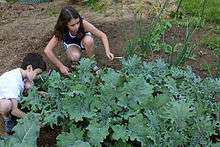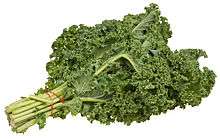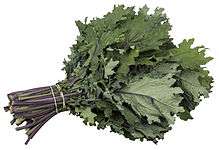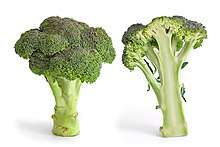Kale
Kale (/keɪl/), or leaf cabbage, belongs to a group of cabbage (Brassica oleracea) cultivars grown for their edible leaves, although some are used as ornamentals. Kale plants have green or purple leaves, and the central leaves do not form a head (as with headed cabbage). Kales are considered to be closer to wild cabbage than most of the many domesticated forms of Brassica oleracea.[1]
| Kale | |
|---|---|
 Curly kale, one of the many varieties of kale | |
| Species | Brassica oleracea |
| Cultivar group | Acephala Group |
| Origin | Unknown, but before the Middle Ages |
| Cultivar group members | Many; see text. |
Etymology
Kale originates from Northern Middle English cale (compare Scots kail) for various cabbages. The ultimate origin is Latin caulis 'cabbage'.[2]
History

Kale originated in the eastern Mediterranean and Asia Minor, where it was cultivated for food beginning by 2000 BC at the latest.[3] Curly-leaved varieties of cabbage already existed along with flat-leaved varieties in Greece in the 4th century BC. These forms, which were referred to by the Romans as Sabellian kale, are considered to be the ancestors of modern kales.
The earliest record of cabbages in western Europe is of hard-heading cabbage in the 13th century.[3] Records in 14th-century England distinguish between hard-heading cabbage and loose-leaf kale.[3]
Russian kale was introduced into Canada, and then into the United States, by Russian traders in the 19th century.[3] USDA botanist David Fairchild is credited with introducing kale (and many other crops) to Americans,[4][5] having brought it back from Croatia,[5] although Fairchild himself disliked cabbages, including kale.[5] At the time, kale was widely grown in Croatia mostly because it was easy to grow and inexpensive, and could desalinate soil.[5] For most of the twentieth century, kale was primarily used in the United States for decorative purposes; it became more popular as an edible vegetable in the 1990s due to its nutritional value.[5]
During World War II, the cultivation of kale (and other vegetables) in the U.K. was encouraged by the Dig for Victory campaign.[6] The vegetable was easy to grow and provided important nutrients missing from a diet because of rationing.[7]
Cultivation
Kale is usually an annual plant grown from seed with a wide range of germination temperatures.[8] It is hardy and thrives in wintertime,[8] and can survive in temperatures as low as –15° Celsius.[9] Kale can become sweeter after a heavy frost.[10]
Cultivars
One may differentiate between kale varieties according to the low, intermediate, or high length of the stem, along with the variety of leaf types. The leaf colours range from light green to green, to dark green and violet-green, to violet-brown.
Classification by leaf type:
- Curly-leaf (Scots kale, blue curled kale)
- Bumpy-leaf (black cabbage, better known by its Italian translation 'cavolo nero', and also known as Tuscan Cabbage, Tuscan Kale, lacinato and dinosaur kale)
- Plain-leaf (flat-leaf types like red Russian and white Russian kale)
- Leaf and spear, or feathery-type leaf (a cross between curly- and plain-leaf)
- Ornamental (less palatable and tougher leaves)

Because kale can grow well into winter, one variety of rape kale is called "hungry gap" after the period in winter in traditional agriculture when little else could be harvested. An extra-tall variety is known as Jersey kale or cow cabbage.[11] Kai-lan or Chinese kale is a cultivar often used in Chinese cuisine. In Portugal, the bumpy-leaved kale is mostly called "couve galega" (Galician kale or Portuguese Cabbage).[12]
Ornamental kale
Many varieties of kale and cabbage are grown mainly for ornamental leaves that are brilliant white, red, pink, lavender, blue or violet in the interior of the rosette. The different types of ornamental kale are peacock kale, coral prince, kamone coral queen, color up kale and chidori kale.[13] Ornamental kale is as edible as any other variety, but potentially not as palatable.[14] Kale leaves are increasingly used as an ingredient for vegetable bouquets and wedding bouquets.[15]
Nutritional value
| Nutritional value per 100 g (3.5 oz) | |
|---|---|
| Energy | 207 kJ (49 kcal) |
8.8 g | |
| Sugars | 2.3 g |
| Dietary fiber | 3.6 g |
0.9 g | |
4.3 g | |
| Vitamins | Quantity %DV† |
| Vitamin A equiv. | 30% 241 μg6261 μg |
| Thiamine (B1) | 10% 0.11 mg |
| Riboflavin (B2) | 11% 0.13 mg |
| Niacin (B3) | 7% 1.0 mg |
| Pantothenic acid (B5) | 18% 0.9 mg |
| Vitamin B6 | 21% 0.27 mg |
| Folate (B9) | 35% 141 μg |
| Choline | 0% 0.8 mg |
| Vitamin C | 145% 120 mg |
| Vitamin E | 10% 1.54 mg |
| Vitamin K | 371% 390 μg |
| Minerals | Quantity %DV† |
| Calcium | 15% 150 mg |
| Iron | 12% 1.5 mg |
| Magnesium | 13% 47 mg |
| Manganese | 31% 0.66 mg |
| Phosphorus | 13% 92 mg |
| Potassium | 10% 491 mg |
| Selenium | 1% 0.9 μg |
| Sodium | 3% 38 mg |
| Zinc | 6% 0.6 mg |
| Other constituents | Quantity |
| Water | 84.0 g |
| |
| †Percentages are roughly approximated using US recommendations for adults. | |
| Nutritional value per 100 g (3.5 oz) | |
|---|---|
| Energy | 117 kJ (28 kcal) |
5.63 g | |
| Sugars | 1.25 g |
| Dietary fiber | 2 g |
0.4 g | |
1.9 g | |
| Vitamins | Quantity %DV† |
| Vitamin A equiv. | 18% 146 μg4983 μg |
| Thiamine (B1) | 5% 0.053 mg |
| Riboflavin (B2) | 6% 0.07 mg |
| Niacin (B3) | 3% 0.5 mg |
| Pantothenic acid (B5) | 1% 0.05 mg |
| Vitamin B6 | 11% 0.138 mg |
| Folate (B9) | 3% 13 μg |
| Choline | 0% 0.4 mg |
| Vitamin C | 49% 41 mg |
| Vitamin E | 6% 0.85 mg |
| Vitamin K | 398% 418 μg |
| Minerals | Quantity %DV† |
| Calcium | 7% 72 mg |
| Iron | 7% 0.9 mg |
| Magnesium | 5% 18 mg |
| Manganese | 20% 0.416 mg |
| Phosphorus | 4% 28 mg |
| Potassium | 5% 228 mg |
| Selenium | 1% 0.9 μg |
| Sodium | 2% 23 mg |
| Zinc | 3% 0.24 mg |
| Other constituents | Quantity |
| Water | 91.2 g |
| |
| †Percentages are roughly approximated using US recommendations for adults. | |
Raw kale is composed of 84% water, 9% carbohydrates, 4% protein, and 1% fat (table). In a 100 g (3 1⁄2 oz) serving, raw kale provides 207 kilojoules (49 kilocalories) of food energy and a large amount of vitamin K at 3.7 times the Daily Value (DV) (table). It is a rich source (20% or more of the DV) of vitamin A, vitamin C, vitamin B6, folate, and manganese (see table "Kale, raw"). Kale is a good source (10–19% DV) of thiamin, riboflavin, pantothenic acid, vitamin E and several dietary minerals, including iron, calcium, potassium, and phosphorus (see table "Kale, raw"). Boiling raw kale diminishes most of these nutrients, while values for vitamins A, C, and K, and manganese remain substantial (see table "Kale, cooked").
Phytochemicals
Kale is a source of the carotenoids, lutein and zeaxanthin (tables).[16] As with broccoli and other cruciferous vegetables, kale contains glucosinolate compounds, such as glucoraphanin, which contributes to the formation of sulforaphane,[17] a compound under preliminary research for its potential to affect human health.[18]
Boiling kale decreases the level of glucosinate compounds, whereas steaming, microwaving or stir frying does not cause significant loss.[19] Kale is high in oxalic acid, the levels of which can be reduced by cooking.[20]
Kale contains high levels of polyphenols, such as ferulic acid,[21] with levels varying due to environmental and genetic factors.[22]
Culinary uses
As a snack product
Flavored "kale chips" have been produced as a potato chip substitute.[23]
Regional uses
Europe
In the Netherlands, a traditional winter dish called "boerenkoolstamppot" is a mix of curly kale and mashed potatoes, sometimes with fried bacon, and served with rookworst ("smoked sausage").[24]
In Northern Germany, there is a winter tradition known as "Kohlfahrt" ("kale trip"), where a group of people will go on a hike through the woods during the day before gathering at an inn where kale is served, usually with bacon and Kohlwurst ("kale sausage").[25] Kale is considered a Northern German staple and comfort food.[26]
In Italy, cavolo nero kale is an ingredient of the Tuscan soup ribollita.[27]
A traditional Portuguese soup, caldo verde, combines pureed potatoes, diced kale, olive oil and salt.[28] Additional ingredients can include broth and sliced, cooked spicy sausage.
In Scotland, kale provided such a base for a traditional diet that the word in some Scots dialects is synonymous with food. To be "off one's kail" is to feel too ill to eat.[29]
In Ireland, kale is mixed with mashed potatoes to make the traditional dish colcannon.[30] It is popular on Halloween,[31] when it may be served with sausages.
In literature
The Kailyard school of Scottish writers, which included J. M. Barrie (creator of Peter Pan), consisted of authors who wrote about traditional rural Scottish life (kailyard = 'kale field').[32] In Cuthbertson's book Autumn in Kyle and the charm of Cunninghame, he states that Kilmaurs in East Ayrshire was famous for its kale, which was an important foodstuff. A story is told in which a neighbouring village offered to pay a generous price for some kale seeds, an offer too good to turn down. The locals agreed, but a gentle roasting on a shovel over a coal fire ensured that the seeds never germinated.[33]
Gallery
 Curly-leaf kale
Curly-leaf kale Red Russian kale
Red Russian kale.jpg) Tuscan kale
Tuscan kale Making kale chips in Illinois
Making kale chips in Illinois A traditional New Years Danish dish: boiled ham, glazed potatoes and stewed kale
A traditional New Years Danish dish: boiled ham, glazed potatoes and stewed kale
See also
- Bowen's Kale
- Crambe maritima – sea kale
- Leaf vegetable
- Kalettes
- Cabbage
References
- Tomar, BS. VK Science – Biology. FK Publications. p. 149. ISBN 978-81-88597-06-2. Archived from the original on 17 June 2016.
- "Kale". Online Etymology Dictionary, Douglas Harper. 2016. Archived from the original on 11 September 2016. Retrieved 16 August 2016.
- Perry, Leonard. "Interesting cool crops". University of Vermont Extension, Department of Plant and Soil Science. Retrieved 5 June 2018.
- Diamond, Anna (January 2018). "America's First "Food Spy" Traveled the World Hunting for Exotic Crops". Smithsonian. Retrieved 5 June 2018.
- Graber, Cynthia; Twilley, Nicola. "Meet the Man Who Found, Finagled, and Ferried Home the Foods We Eat Today". Gastropod. Retrieved 5 June 2018.
- Titchmarsh, Alan (3 May 2015). "Land army: Alan Titchmarsh on how gardening became essential for survival during wartime". The Express. Retrieved 5 August 2017.
- "World War Two vegetable comes back as 'superfood'". Daily Mail. London. 3 October 2007. Archived from the original on 23 September 2008.
- "Growing guide for kale". Cornell University, Ithaca, NY. 2006. Archived from the original on 4 November 2016. Retrieved 7 November 2016.
- Derek B. Munro Vegetables of Canada, p. 120, at Google Books
- Watson, Benjamin (1996). Taylor's Guide to Heirloom Vegetables. Boston: Houghton Mifflin. p. 200. ISBN 978-0-395-70818-7.
kale frost.
- Bailey, L. H., (1912, republished in 1975). Jersey kale Photo. In Cyclopedia of American Agriculture: Vol. II--crops Archived 27 April 2016 at the Wayback Machine. Macmillan Publishing, New York. pp. 389–90. ISBN 0-405-06762-3.
- "Couve Galega (Portuguese Cabbage)". myfolia.com. Archived from the original on 28 August 2017. Retrieved 3 June 2017.
- "Is Ornamental Kale Edible? Yes, But Not That Tasty". Garden.eco. 14 December 2017. Retrieved 2 March 2018.
- Larkcom, Joy (1 June 2003). The Organic Salad Garden. frances lincoln ltd. pp. 30–32. ISBN 978-0-7112-2204-5. Archived from the original on 29 June 2014. Retrieved 30 August 2012.
- Jamieson, Sophie (30 October 2015). "Kale, broccoli and cabbage replace traditional flowers as brides opt for vegetable wedding bouquets". The Telegraph. Archived from the original on 18 March 2017. Retrieved 25 March 2017.
- Walsh RP, Bartlett H, Eperjesi F (2015). "Variation in Carotenoid Content of Kale and Other Vegetables: A Review of Pre- and Post-harvest Effects". J Agric Food Chem. 63 (Oct 28): 9677–82. doi:10.1021/acs.jafc.5b03691. PMID 26477753.
- Kushad MM, Brown AF, Kurilich AC, Juvik JA, Klein BP, Wallig MA, Jeffery EH (1999). "Variation of glucosinolates in vegetable crops of Brassica oleracea". J Agric Food Chem. 47 (4): 1541–8. doi:10.1021/jf980985s. PMID 10564014.
- Houghton, C. A.; Fassett, R. G.; Coombes, J. S. (2013). "Sulforaphane: Translational research from laboratory bench to clinic". Nutrition Reviews. 71 (11): 709–26. doi:10.1111/nure.12060. PMID 24147970.
- Nugrahedi, P. Y.; Verkerk, R; Widianarko, B; Dekker, M (2015). "A mechanistic perspective on process-induced changes in glucosinolate content in Brassica vegetables: A review". Critical Reviews in Food Science and Nutrition. 55 (6): 823–38. doi:10.1080/10408398.2012.688076. PMID 24915330.
- Armesto, Jorge; Gómez-Limia, Lucía; Carballo, Javier; Martínez, Sidonia (23 July 2018). "Effects of different cooking methods on the antioxidant capacity and flavonoid, organic acid and mineral contents of Galega kale (Brassica oleracea var. acephala cv. Galega)". International Journal of Food Sciences and Nutrition. 70 (2): 136–149. doi:10.1080/09637486.2018.1482530. ISSN 0963-7486. PMID 30037287.
- Korus, Anna; Lisiewska, Zofia (2011). "Effect of preliminary processing and method of preservation on the content of selected antioxidative compounds in kale (Brassica oleracea L. var. acephala) leaves". Food Chemistry. 129 (1): 149–154. doi:10.1016/j.foodchem.2011.04.048.
- Zietz, Michaela; Weckmüller, Annika; Schmidt, Susanne; Rohn, Sascha; Schreiner, Monika; Krumbein, A; Kroh, Lothar W (2010). "Genotypic and Climatic Influence on the Antioxidant Activity of Flavonoids in Kale (Brassica oleracea var. sabellica)". Journal of Agricultural and Food Chemistry. 58 (4): 2123–2130. doi:10.1021/jf9033909. PMID 20095605.
- "A kid-friendly potato chip alternative". The Washington Post. 23 June 2015. Archived from the original on 2 April 2017. Retrieved 2 April 2017.
- Harvard Student Agencies, Inc. (2013). Let's Go Paris, Amsterdam & Brussels: The Student Travel Guide. Let's go travel guide. Avalon Travel Publishing. p. 503. ISBN 978-1-61237-028-6. Retrieved 2 April 2017.
- "Bremen's unique tradition | European Traveler". europeantraveler.net. Retrieved 24 February 2020.
- Gorman, Louise (11 April 2016). "On the kale tour trail in Germany, schnapps in hand". sbs.com.au. Retrieved 24 February 2020.
- Gray, R.; Rogers, R. (2013). The River Cafe Cookbook. Ebury Publishing. p. pt80. ISBN 978-1-4464-6035-1. Retrieved 2 April 2017.
- The Illustrated Cook's Book of Ingredients. The Illustrated Cook's Book of Ingredients. DK Publishing. 2010. p. 193. ISBN 978-0-7566-7673-5. Retrieved 2 April 2017.
- "THE LAZY GARDENER 'Off one's kail' you'll be if you eat these winter beauties". 4 December 2009. Archived from the original on 27 August 2017. Retrieved 3 June 2017.
- Wise, V.; Hawken, S. (1999). The Gardeners' Community Cookbook. Workman Pub. p. 276. ISBN 978-0-7611-1772-8. Retrieved 2 April 2017.
- Rogers, N. (2003). Halloween: From Pagan Ritual to Party Night. Oxford University Press. p. 47. ISBN 978-0-19-516896-9. Archived from the original on 2 May 2016. Retrieved 2 April 2017.
- Scott, Maggie. "Scots Word of the Season: Kailyard". arts.gla.ac.uk. Archived from the original on 3 March 2016. Retrieved 13 June 2017.
- Cuthbertson, David Cuningham (1945). Autumn in Kyle and the Charm of Cunninghame. London: Jenkins. Page 186
External links
| Look up kale in Wiktionary, the free dictionary. |
| Wikimedia Commons has media related to |
- Marrow-Stem Kale – Plants for a Future database
- PROTAbase on Brassica oleracea (leaf cabbage)
